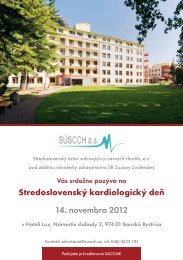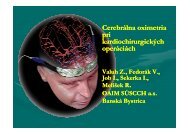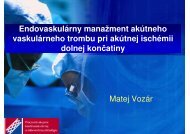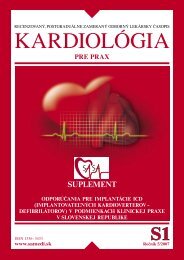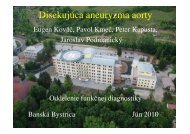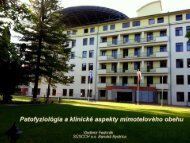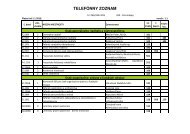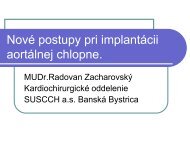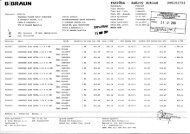Management of acute myocardial infarction in patients presenting ...
Management of acute myocardial infarction in patients presenting ...
Management of acute myocardial infarction in patients presenting ...
You also want an ePaper? Increase the reach of your titles
YUMPU automatically turns print PDFs into web optimized ePapers that Google loves.
ESC Guidel<strong>in</strong>es 2929<br />
presence <strong>of</strong> ret<strong>in</strong>opathy. 158 Furthermore, treatment with stat<strong>in</strong>s,<br />
b-blockers, and ACE-<strong>in</strong>hibitors seems to be at least as effective and<br />
safe <strong>in</strong> diabetic <strong>patients</strong> as <strong>in</strong> non-diabetic <strong>patients</strong>. 157,159–161<br />
Deterioration <strong>of</strong> the glucometabolic state <strong>of</strong> diabetic <strong>patients</strong> at<br />
the time <strong>of</strong> admission for an <strong>acute</strong> coronary event, reflect<strong>in</strong>g an<br />
<strong>acute</strong> stress response to sudden impairment <strong>of</strong> LV function,<br />
appears to have an effect on outcome. Higher glucose levels on<br />
admission are <strong>in</strong>deed associated with <strong>in</strong>creased mortality rates <strong>in</strong><br />
diabetic <strong>patients</strong> present<strong>in</strong>g with STEMI. 162,163 Strict attention to<br />
the glycaemic control by use <strong>of</strong> <strong>in</strong>sul<strong>in</strong> <strong>in</strong>fusion followed by<br />
multiple-dose <strong>in</strong>sul<strong>in</strong> treatment has been shown to reduce longterm<br />
mortality as compared with rout<strong>in</strong>e oral antidiabetic<br />
therapy <strong>in</strong> diabetic <strong>patients</strong>. 164 – 166 In the more recent DIGAMI-2<br />
study (n ¼ 1253 <strong>patients</strong>), however, mortality did not differ significantly<br />
between diabetic <strong>patients</strong> randomized to either <strong>acute</strong> <strong>in</strong>sul<strong>in</strong><br />
<strong>in</strong>fusion followed by <strong>in</strong>sul<strong>in</strong>-based long-term glucose control,<br />
<strong>in</strong>sul<strong>in</strong> <strong>in</strong>fusion followed by standard glucose control, or standard<br />
glucometabolic management, probably reflect<strong>in</strong>g a lack <strong>of</strong> difference<br />
<strong>in</strong> glucose control among the three groups, 167 Because<br />
hyperglycaemia rema<strong>in</strong>ed one <strong>of</strong> the most important predictors<br />
<strong>of</strong> outcome <strong>in</strong> this study, however, it appears to be reasonable<br />
to keep glucose levels with<strong>in</strong> normal ranges <strong>in</strong> diabetic <strong>patients</strong>.<br />
Target glucose levels between 90 and 140 mg/dL (5 and<br />
7.8 mmol/L) have been suggested. 168 Care needs to be taken to<br />
avoid blood glucose levels below 80–90 mg/dL (4.4–5 mmol/L),<br />
however, as hypoglycaemia-<strong>in</strong>duced ischaemia might also affect<br />
outcome <strong>in</strong> diabetic <strong>patients</strong> with <strong>acute</strong> coronary syndromes. 169<br />
c. Patients with renal dysfunction<br />
The 2-year mortality rate among STEMI <strong>patients</strong> with end-stage<br />
renal disease (creat<strong>in</strong><strong>in</strong>e clearance ,30 mL/m<strong>in</strong>) is much higher<br />
than <strong>in</strong> the general population, 170 which might be expla<strong>in</strong>ed on<br />
the one hand by a higher proportion <strong>of</strong> cardiovascular risk<br />
factors and on the other hand by the fact that <strong>acute</strong> reperfusion<br />
strategies are <strong>of</strong>fered to these <strong>patients</strong> less frequently because <strong>of</strong><br />
fear <strong>of</strong> higher bleed<strong>in</strong>g rates and contrast medium-<strong>in</strong>duced renal<br />
failure. 171,172<br />
Although recommendations for STEMI <strong>patients</strong> with renal dysfunction<br />
are essentially the same as for <strong>patients</strong> without renal<br />
disease, the risk <strong>of</strong> a further detoriation <strong>of</strong> renal function must<br />
be taken <strong>in</strong>to account when adm<strong>in</strong>ister<strong>in</strong>g contrast dye dur<strong>in</strong>g<br />
primary PCI and prescrib<strong>in</strong>g drugs such as ACE-<strong>in</strong>hibitors, ARBs,<br />
and diuretics.<br />
E. <strong>Management</strong> <strong>of</strong> the later<br />
<strong>in</strong>-hospital course<br />
<strong>Management</strong> <strong>of</strong> the later <strong>in</strong>-hospital phase will be determ<strong>in</strong>ed by<br />
the amount <strong>of</strong> <strong>myocardial</strong> necrosis, the demographic characteristics<br />
<strong>of</strong> the <strong>patients</strong>, and the presence or absence <strong>of</strong> co-morbidity.<br />
While the patient who has become asymptomatic and with<br />
m<strong>in</strong>imum <strong>myocardial</strong> damage may go home after a few days, particularly<br />
after a successful PCI, <strong>patients</strong> with significant LV dysfunction<br />
or those who are at risk <strong>of</strong> new events may require a longer<br />
hospitalization.<br />
1. Ambulation<br />
Patients with significant LV damage should rest <strong>in</strong> bed for the first<br />
12–24 h, by which time it will be apparent whether the <strong><strong>in</strong>farction</strong><br />
is go<strong>in</strong>g to be complicated. In uncomplicated cases, the patient can<br />
sit out <strong>of</strong> bed late on the first day, be allowed to use a commode,<br />
and undertake self-care and self-feed<strong>in</strong>g. Ambulation can start the<br />
next day, and such <strong>patients</strong> can be walk<strong>in</strong>g up to 200 m on the flat,<br />
and walk<strong>in</strong>g up stairs with<strong>in</strong> a few days. Those who have experienced<br />
heart failure, shock, or serious arrhythmias should be<br />
kept <strong>in</strong> bed longer, and their physical activity <strong>in</strong>creased slowly,<br />
dependent upon their symptoms and the extent <strong>of</strong> <strong>myocardial</strong><br />
damage.<br />
2. <strong>Management</strong> <strong>of</strong> specific <strong>in</strong>-hospital<br />
complications<br />
a. Deep ve<strong>in</strong> thrombosis and pulmonary embolism<br />
These complications are now relatively uncommon after <strong><strong>in</strong>farction</strong>,<br />
except <strong>in</strong> <strong>patients</strong> kept <strong>in</strong> bed because <strong>of</strong> heart failure. In such<br />
<strong>patients</strong>, they can be prevented by prophylactic doses <strong>of</strong> a<br />
LMWH and the application <strong>of</strong> compression stock<strong>in</strong>gs. When<br />
they occur, they should be treated with therapeutic doses <strong>of</strong> a<br />
LMWH, followed by oral anticoagulation for 3–6 months.<br />
b. Intraventricular thrombus and systemic emboli<br />
Echocardiography may reveal <strong>in</strong>traventricular thrombi, especially <strong>in</strong><br />
<strong>patients</strong> with large anterior <strong><strong>in</strong>farction</strong>s. If the thrombi are mobile or<br />
protuberant, they should be treated <strong>in</strong>itially with i.v. unfractionated<br />
hepar<strong>in</strong> or LMWH, and subsequently with oral anticoagulants for<br />
at least 3–6 months.<br />
c. Pericarditis<br />
Acute pericarditis may complicate STEMI with transmural necrosis.<br />
It gives rise to chest pa<strong>in</strong> that may be mis<strong>in</strong>terpreted as recurrent<br />
<strong><strong>in</strong>farction</strong> or ang<strong>in</strong>a. The pa<strong>in</strong> is, however, dist<strong>in</strong>guished by its sharp<br />
nature, and its relationship to posture and respiration. The diagnosis<br />
may be confirmed by a pericardial rub. If the pa<strong>in</strong> is troublesome,<br />
it may be treated by high-dose i.v. aspir<strong>in</strong> (1000 mg/24 h)<br />
or NSAIDs. A haemorrhagic effusion with tamponade is uncommon<br />
and is particularly associated with antithromb<strong>in</strong> treatment.<br />
It can usually be recognized echocardiographically. Treatment is<br />
by pericardiocentesis if haemodynamic compromise occurs.<br />
Antithromb<strong>in</strong> therapy must be <strong>in</strong>terrupted unless there is an<br />
absolute <strong>in</strong>dication for its cont<strong>in</strong>uous use.<br />
d. Late ventricular arrhythmias<br />
VT and VF occurr<strong>in</strong>g dur<strong>in</strong>g the first 24–48 h have a low predictive<br />
value for recurr<strong>in</strong>g risk <strong>of</strong> arrhythmias over time. Arrhythmias<br />
develop<strong>in</strong>g later are liable to recur and are associated with an<br />
<strong>in</strong>creased risk <strong>of</strong> sudden death. 173<br />
Aggressive attempts should be made to treat heart failure and to<br />
search for and correct <strong>myocardial</strong> ischaemia <strong>in</strong> <strong>patients</strong> with ventricular<br />
tachyarrhythmias. Myocardial revascularization should be performed,<br />
when appropriate, to reduce the risk <strong>of</strong> sudden death <strong>in</strong> <strong>patients</strong> experienc<strong>in</strong>g<br />
VF or polymorphic VT. 130 No controlled trials, however, have<br />
evaluated the effects <strong>of</strong> <strong>myocardial</strong> revascularization on VT or VF<br />
after STEMI. Observational studies suggest that revascularization is<br />
unlikely to prevent recurrent cardiac arrest <strong>in</strong> <strong>patients</strong> with markedly



